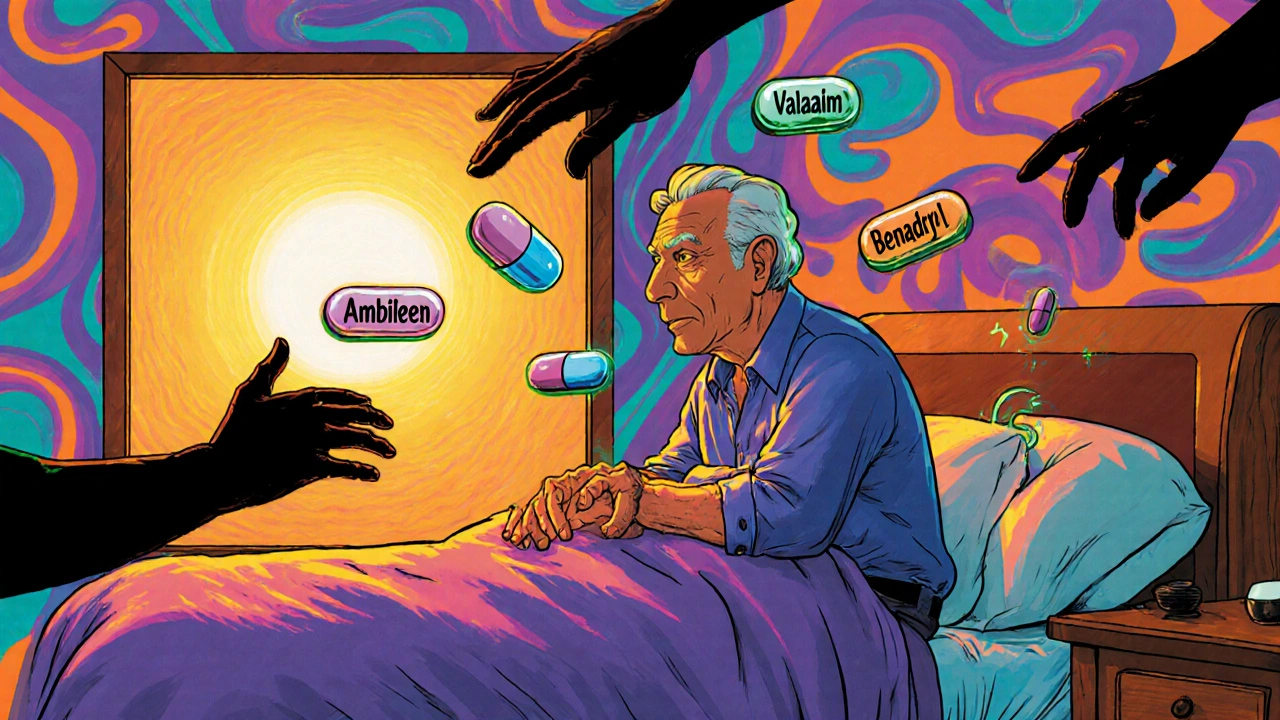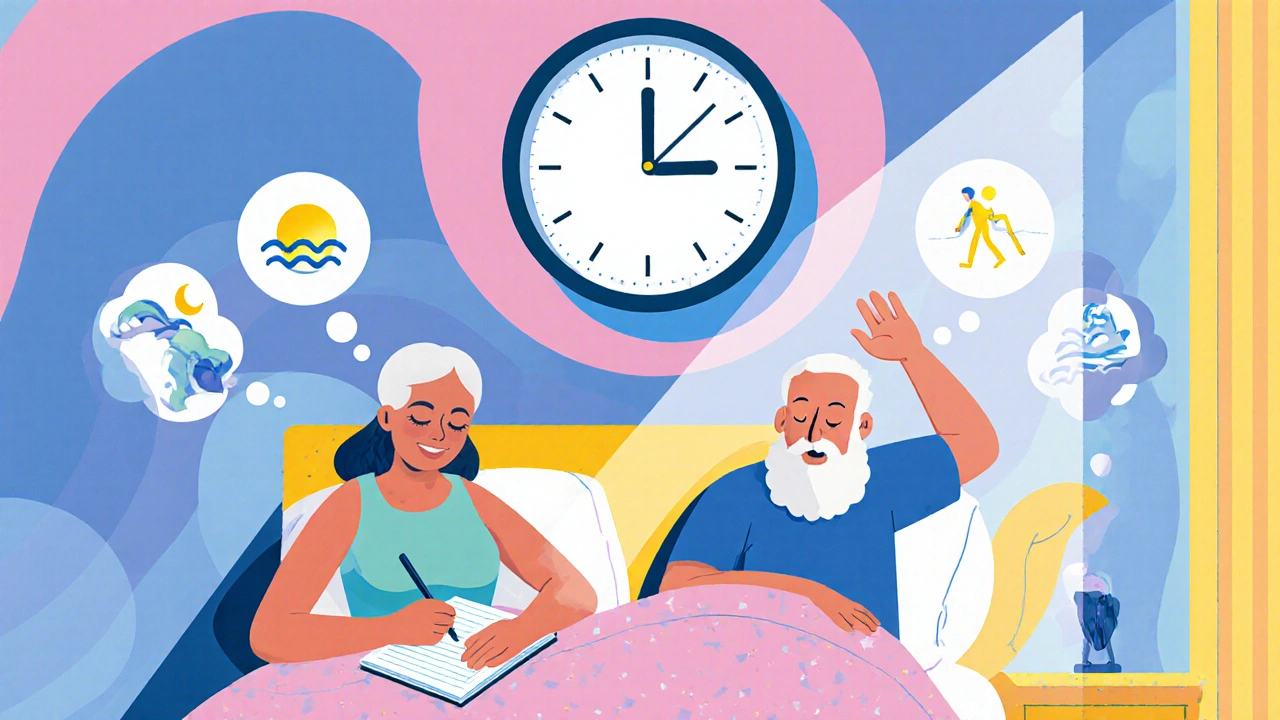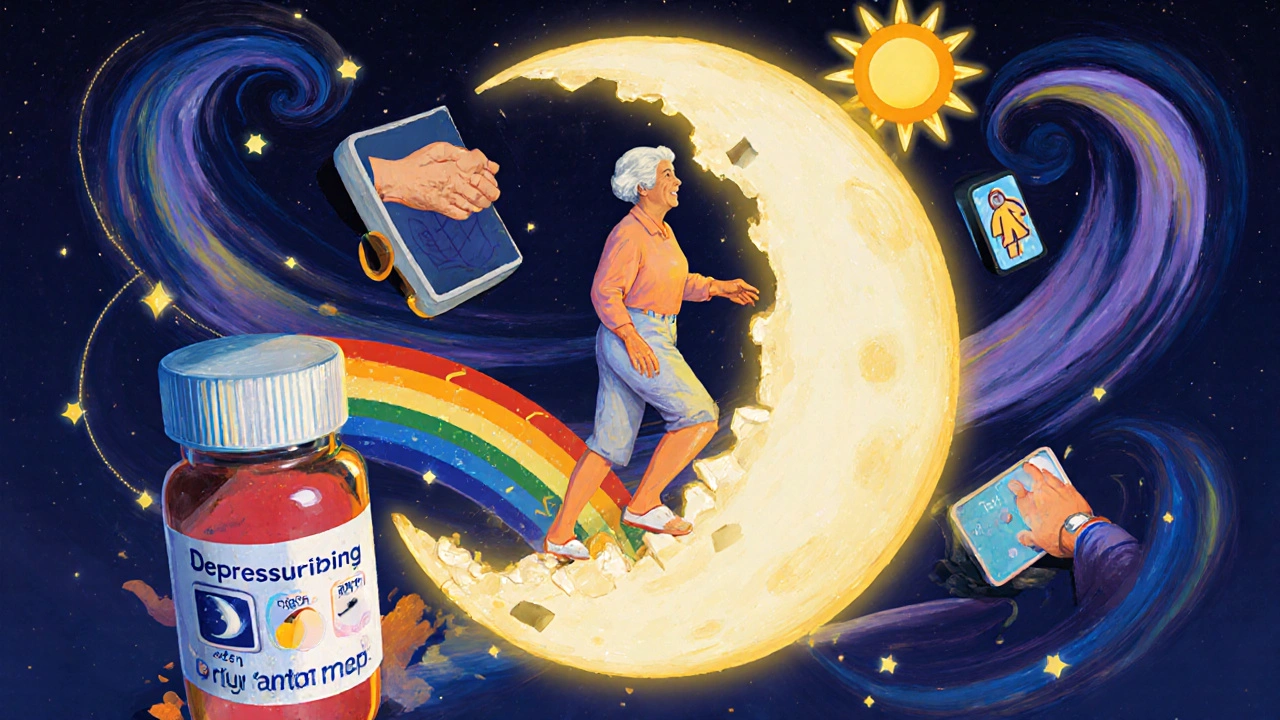Sleep Medications and Sedatives in Seniors: Safer Sleep Strategies
 Nov, 17 2025
Nov, 17 2025
Why Sleep Medications Can Be Dangerous for Seniors
More than half of adults over 65 struggle with sleep. Some turn to pills-prescription or over-the-counter-to get through the night. But for seniors, these medications often do more harm than good. The Beers Criteria, updated in 2019 by the American Geriatrics Society, clearly warns against using benzodiazepines and Z-drugs like zolpidem (Ambien) as first-line treatments for insomnia in older adults. Why? Because the risks far outweigh the benefits.
These drugs slow down brain activity, which can lead to dizziness, confusion, and poor balance. A 2012 study in the Journal of the American Geriatrics Society found that seniors taking long-acting benzodiazepines like flurazepam had a 50% higher chance of falling. Falls are the leading cause of injury-related death in people over 65. One fall can mean a broken hip, months in rehab, or even permanent loss of independence.
There’s also a growing link between long-term use of sleep meds and dementia. A 2014 study in the BMJ showed that seniors who used benzodiazepines for more than six months had an 84% higher risk of developing Alzheimer’s disease. Even newer drugs like zolpidem carry a 30% increased fall risk, according to an FDA safety alert from 2017. And it’s not just physical danger-many seniors wake up groggy, foggy, and disoriented, sometimes not realizing they’ve taken the pill at all.
What Sleep Medications Are Most Risky for Seniors?
Not all sleep aids are created equal. Some are far more dangerous for older adults than others. The most concerning include:
- Benzodiazepines like diazepam (Valium), lorazepam (Ativan), and triazolam (Halcion)-these are old, long-acting, and linger in the body, increasing confusion and fall risk.
- Z-drugs such as zolpidem (Ambien), eszopiclone (Lunesta), and zaleplon (Sonata)-marketed as safer, but still linked to memory problems, next-day drowsiness, and complex sleep behaviors like sleepwalking or driving while asleep.
- Antihistamines like diphenhydramine (Benadryl) and doxylamine (Unisom)-common in OTC sleep aids, these have strong anticholinergic effects that can worsen memory, cause urinary retention, and raise the risk of delirium.
- Trazodone-often prescribed off-label for sleep, it’s cheap and widely used in nursing homes, but can cause dizziness, low blood pressure, and increased fall risk without proven long-term benefits for insomnia.
These medications are still prescribed frequently. In 2021, over 9 million prescriptions for sleep aids were filled by seniors in the U.S. Zolpidem alone made up 43% of those. But the evidence is clear: these drugs are not safe for long-term use in older adults.
The Safer Alternatives: What Actually Works
There are better options-ones that don’t come with a risk of falling or forgetting your own name. The gold standard is cognitive behavioral therapy for insomnia (CBT-I). Unlike pills, CBT-I teaches your brain to sleep naturally. It doesn’t just mask the problem-it fixes the root cause.
CBT-I includes:
- Sleep restriction: Limiting time in bed to match actual sleep time, then gradually increasing it as sleep improves.
- Stimulus control: Only using the bed for sleep and sex-not reading, watching TV, or worrying.
- Cognitive restructuring: Challenging negative thoughts like “I’ll never sleep again” that keep the mind racing.
- Sleep hygiene: Consistent bedtime, avoiding caffeine after noon, keeping the bedroom cool and dark.
A 2019 study in JAMA Internal Medicine found that telehealth CBT-I helped 57% of seniors with chronic insomnia achieve full remission. And 89% stuck with it. That’s better than most drugs.
For those who need medication, a few safer choices exist:
- Low-dose doxepin (Silenor): At 3-6 mg, this antidepressant has minimal side effects. It improves sleep efficiency by 5.3% and adds nearly 30 minutes of sleep without next-day grogginess.
- Ramelteon (Rozerem): A melatonin receptor agonist that helps you fall asleep faster-by about 14 minutes-with no risk of dependence or next-day impairment.
- Lemborexant (Dayvigo): A newer orexin blocker that targets wakefulness signals. A 2021 study in JAMA Internal Medicine found it caused less postural instability than zolpidem in adults 55+.
- Melatonin (2-5 mg): Not a sedative, but a natural hormone that helps regulate sleep-wake cycles. Best for circadian rhythm issues, like delayed sleep phase.

Cost, Access, and the Hidden Inequality in Sleep Care
One big problem with safer sleep treatments? They’re not always affordable. Low-dose doxepin costs around $400 a month without insurance. Generic zolpidem? About $15. That price gap means many seniors stick with the cheaper, riskier options-even when their doctor knows it’s not ideal.
And access isn’t equal. A 2022 UCSF study found white seniors were three times more likely than Black seniors to use sleep medications frequently. That doesn’t mean Black seniors sleep worse-it likely reflects barriers to care. Fewer specialists, less insurance coverage, and mistrust in the medical system mean many older Black adults never even hear about CBT-I or safer alternatives.
Telehealth has helped. Platforms like Sleepio, a digital CBT-I program, achieved 63% response rates in seniors in a 2023 JAMA Neurology study. That’s as effective as in-person therapy. But not everyone has reliable internet, a smartphone, or tech support.
How to Safely Stop Using Sleep Medications
If you or a loved one has been taking sleep pills for months-or years-it’s not safe to quit cold turkey. Suddenly stopping benzodiazepines or Z-drugs can cause rebound insomnia, anxiety, tremors, or even seizures.
The key is gradual tapering, guided by a doctor. The STOPP/START criteria recommend reducing the dose slowly over 4 to 8 weeks. For example:
- Reduce zolpidem from 10 mg to 5 mg for two weeks.
- Then take 5 mg every other night for two weeks.
- Then take 5 mg twice a week for two weeks.
- Stop.
During this time, start CBT-I or another behavioral strategy. The goal isn’t just to stop the pill-it’s to replace it with a sustainable habit.
Many seniors report feeling better after stopping. One woman on AgingCare.com wrote: “After six weeks of CBT-I, I cut my Lunesta from 2 mg to as-needed. I sleep better than I have in 20 years.”

What Seniors and Families Can Do Today
You don’t need to wait for a doctor’s appointment to start improving sleep. Here’s what you can do right now:
- Track sleep: Use a simple notebook or app to record bedtime, wake time, and how rested you feel. Patterns reveal problems.
- Get sunlight: Spend 20-30 minutes outside in the morning. Natural light resets your internal clock.
- Limit screens: Blue light from phones and TVs suppresses melatonin. Avoid screens for at least an hour before bed.
- Move during the day: Even a 20-minute walk improves sleep quality. Avoid vigorous exercise within 3 hours of bedtime.
- Check your meds: Ask your pharmacist or doctor if any of your current prescriptions (like antihistamines for allergies or heartburn meds) are making sleep worse.
- Ask about CBT-I: Say: “Can you refer me to a sleep specialist who offers cognitive behavioral therapy for insomnia?”
And if you’re already on a sleep medication, don’t panic. But do talk to your doctor. Ask: “Is this still necessary? Are there safer options? Can we try reducing it?”
The Future of Sleep for Seniors
The medical community is shifting. The American Geriatrics Society is updating the Beers Criteria in 2024 to push harder for deprescribing. The NIH has invested $15 million in the Seniors Sleep Safety Initiative. Digital CBT-I is becoming standard. And doctors are finally listening.
The future isn’t more pills. It’s personalized care-using sleep diaries, wearable trackers, and behavioral therapy to understand why someone isn’t sleeping, then fixing it without drugs.
For seniors, better sleep doesn’t come from a bottle. It comes from routine, light, movement, and a quiet mind. And that’s something no pill can give you.
Are over-the-counter sleep aids safe for seniors?
Most over-the-counter sleep aids, like those containing diphenhydramine or doxylamine, are not safe for seniors. These antihistamines have strong anticholinergic effects that can cause confusion, memory loss, urinary retention, and increased fall risk. Even though they’re available without a prescription, they’re not recommended for long-term use in adults over 65. The American Geriatrics Society includes them in the Beers Criteria as potentially inappropriate.
Can melatonin help seniors sleep better?
Yes, melatonin can help some seniors, especially if their sleep issues are tied to a disrupted circadian rhythm-like waking up too early or having trouble falling asleep at a normal time. A dose of 2-5 mg taken one hour before bed can improve sleep onset. Unlike sedatives, melatonin doesn’t cause next-day grogginess or increase fall risk. However, it doesn’t work for everyone, especially if insomnia is caused by anxiety, pain, or other medical conditions.
What is CBT-I, and how effective is it for older adults?
CBT-I stands for Cognitive Behavioral Therapy for Insomnia. It’s a structured, short-term therapy that teaches you how to change thoughts and behaviors that interfere with sleep. Studies show it’s as effective as-or more effective than-sleep medications for seniors. A 2019 study found 57% of older adults who completed telehealth CBT-I achieved full remission of insomnia, and 89% stuck with the program. Unlike pills, the benefits last long after treatment ends.
Why do doctors still prescribe sleeping pills to seniors if they’re risky?
Many doctors prescribe sleep meds because they’re quick, familiar, and patients ask for them. CBT-I requires referrals, time, and sometimes insurance approval, which can be hard to navigate. Also, many primary care providers aren’t trained in sleep medicine. But awareness is growing. Programs like Medicare’s “Choosing Wisely” initiative have already cut inappropriate benzodiazepine prescriptions in nursing homes by 24% since 2019.
Is it safe to take sleeping pills with other medications?
It’s often not safe. Many seniors take multiple medications, and sleep aids can interact dangerously with blood pressure drugs, pain relievers, antidepressants, or even heart rhythm medications. For example, combining zolpidem with opioids increases the risk of respiratory depression. Always review all medications with a pharmacist or geriatrician. Never start or stop a sleep aid without medical supervision.
shubham seth
November 18, 2025 AT 04:42Kathryn Ware
November 19, 2025 AT 08:17kora ortiz
November 19, 2025 AT 12:04Jeremy Hernandez
November 21, 2025 AT 11:57Tarryne Rolle
November 22, 2025 AT 05:25Kyle Swatt
November 23, 2025 AT 05:29Deb McLachlin
November 25, 2025 AT 05:05saurabh lamba
November 26, 2025 AT 20:28